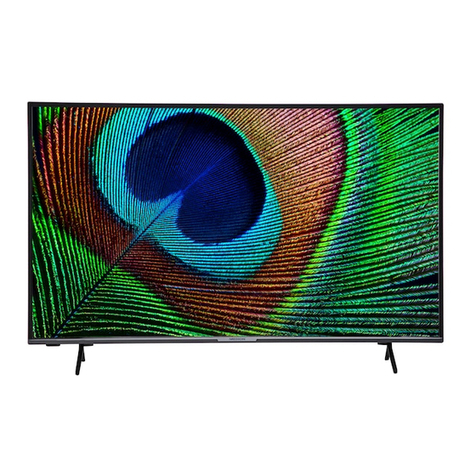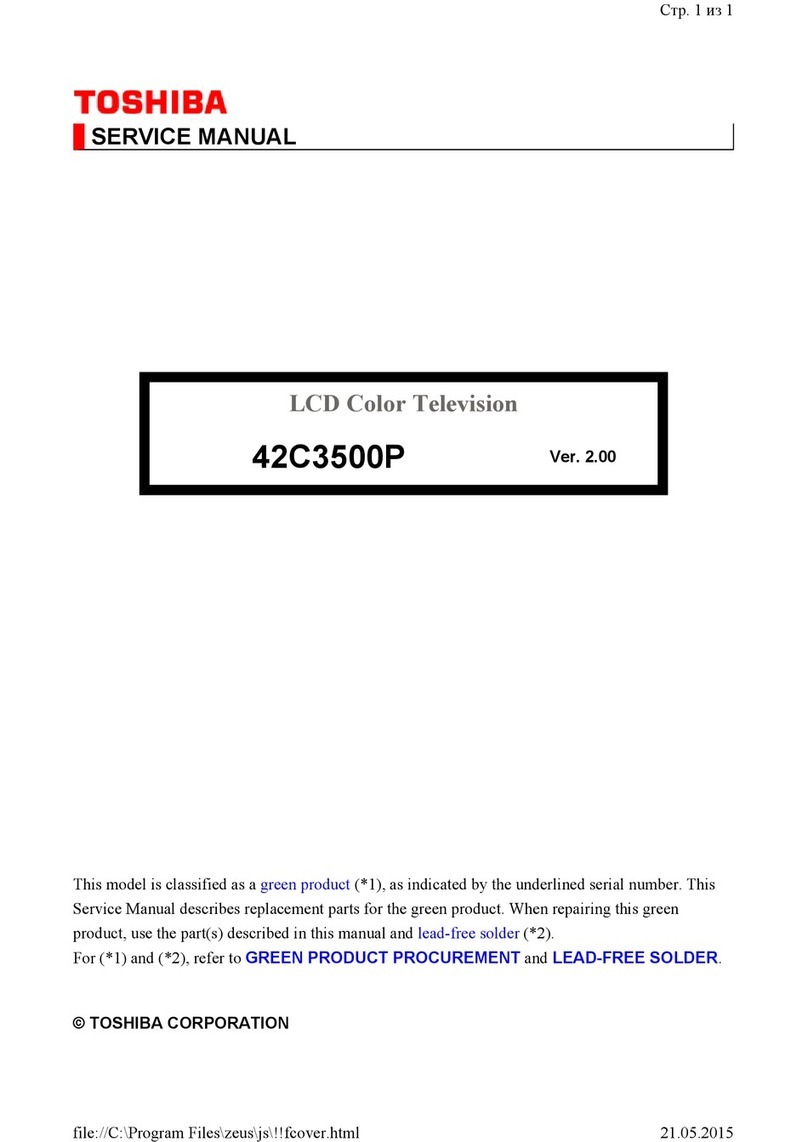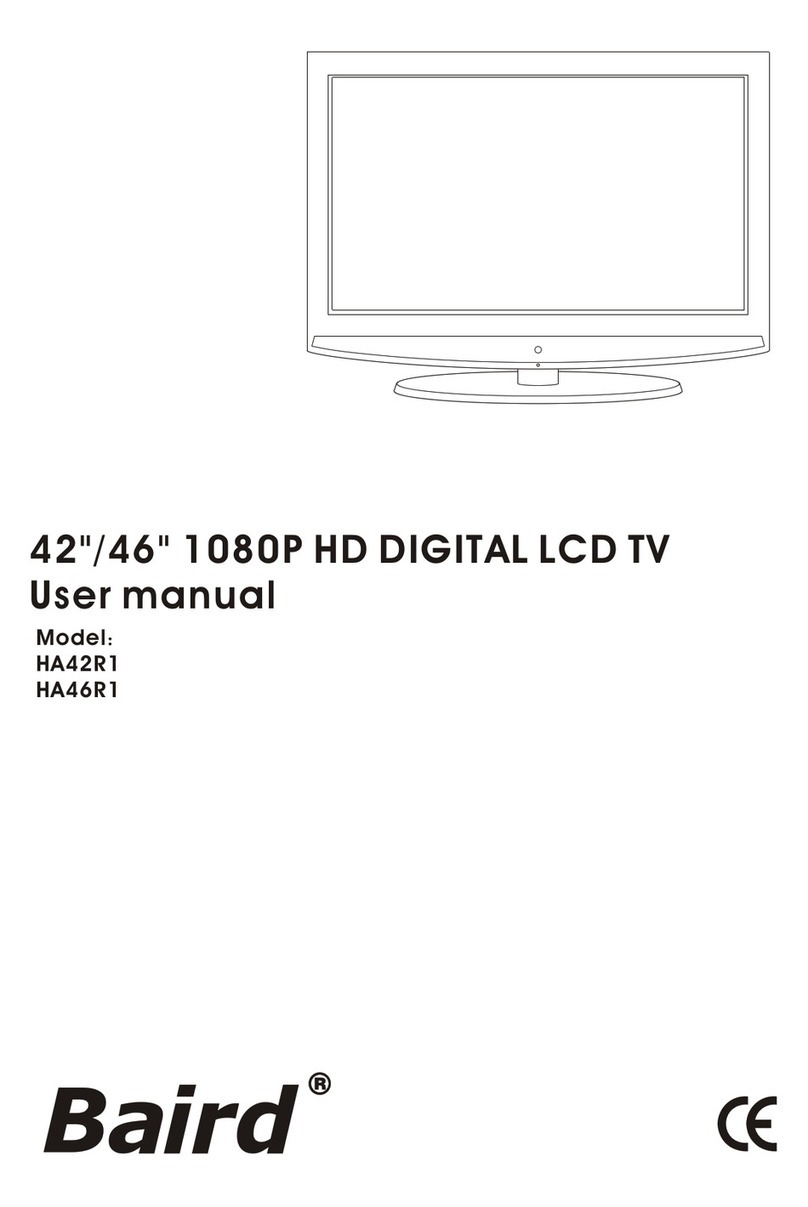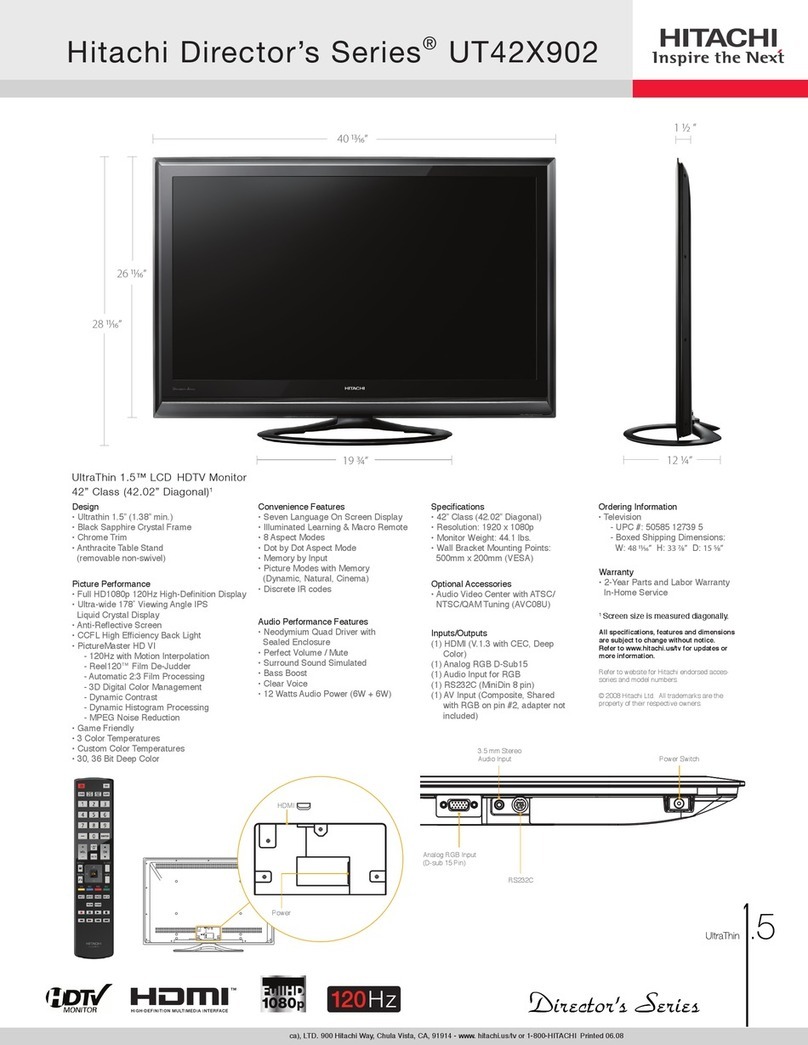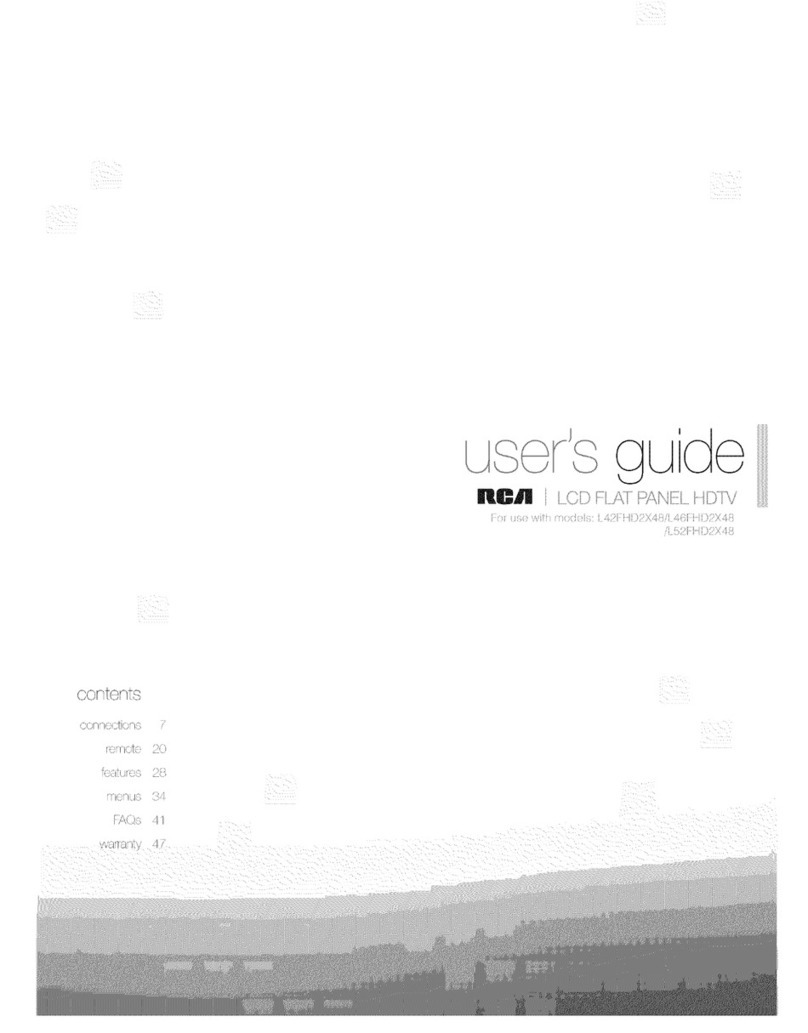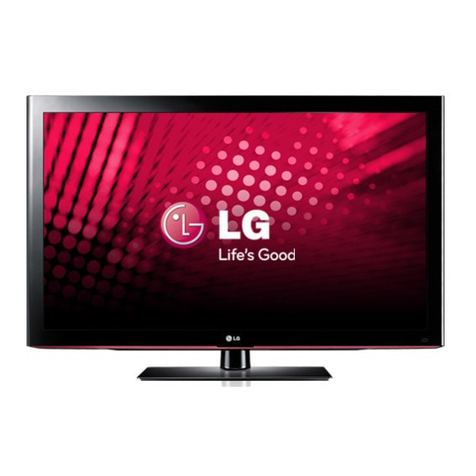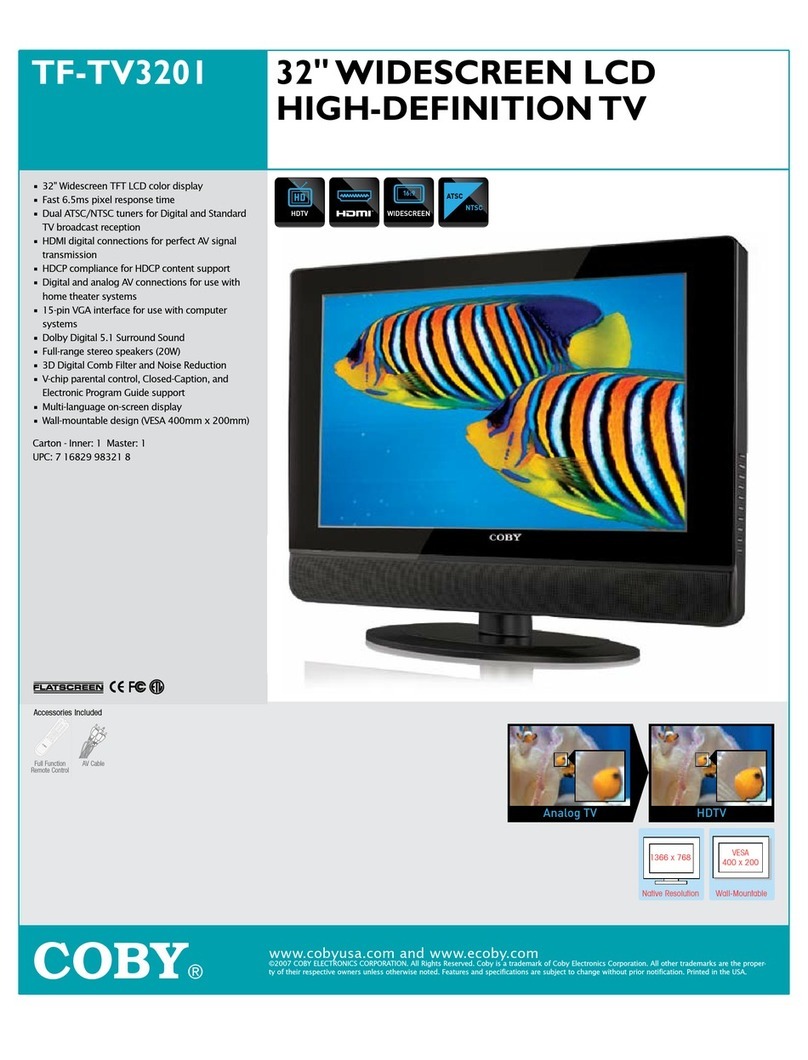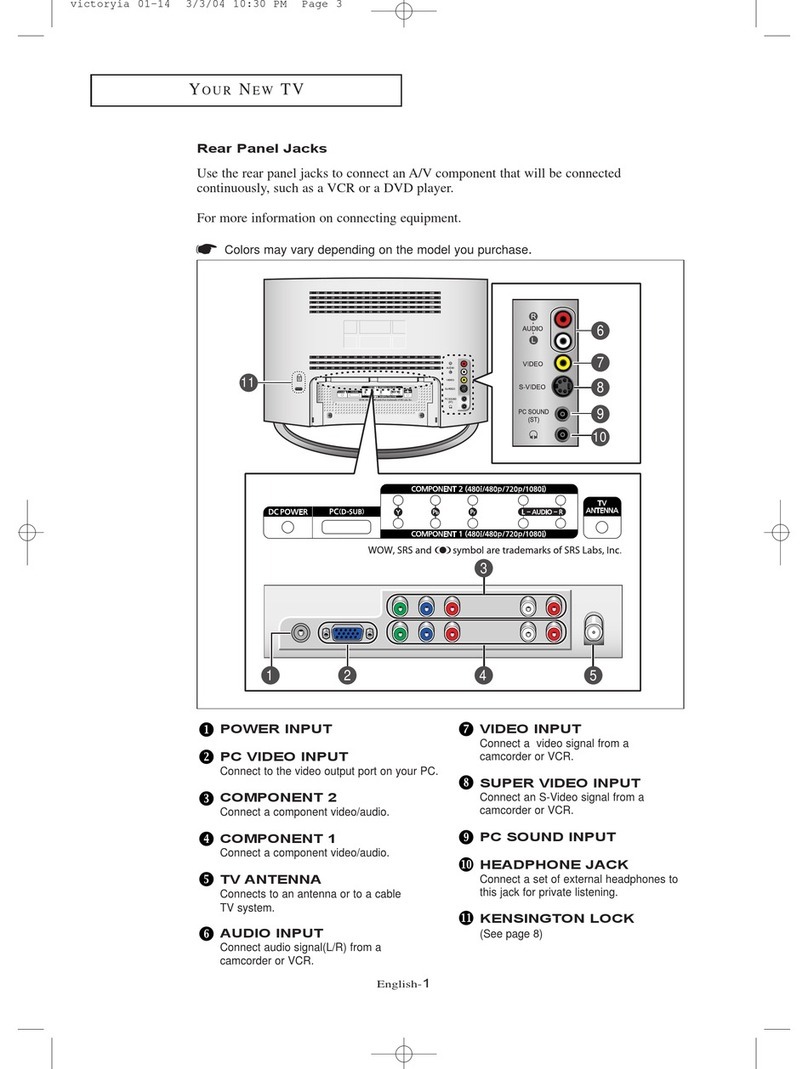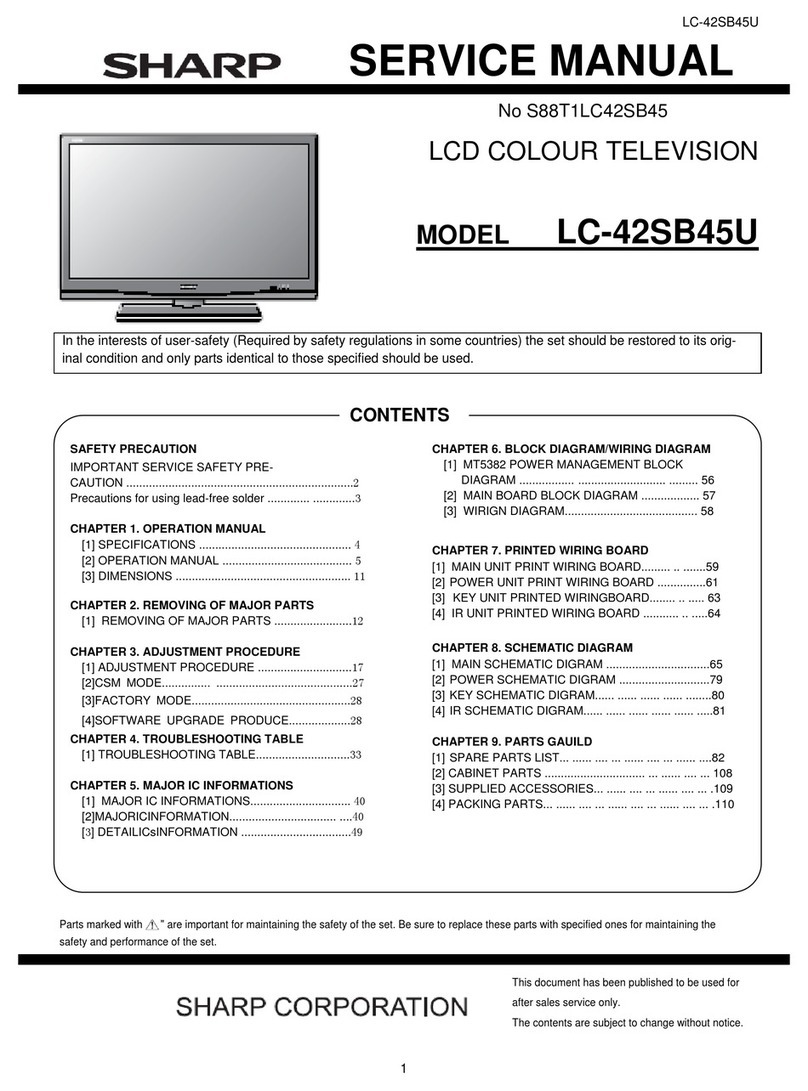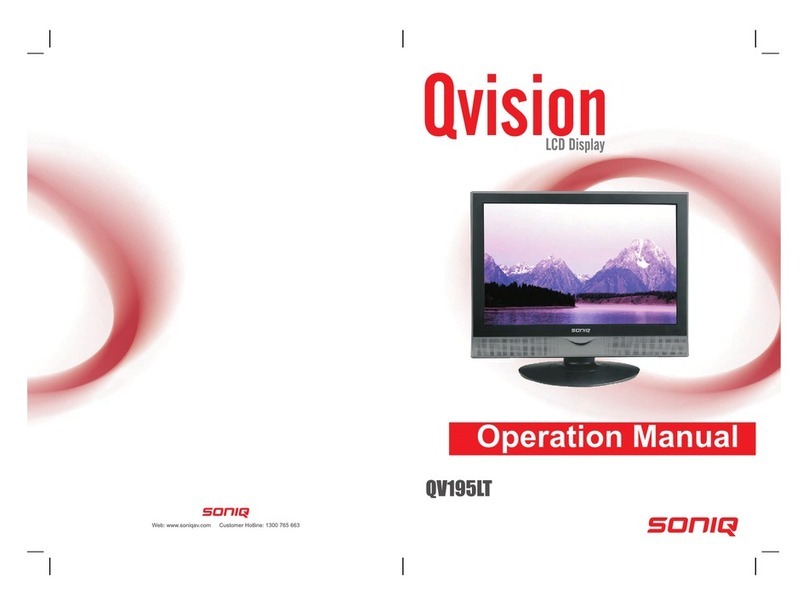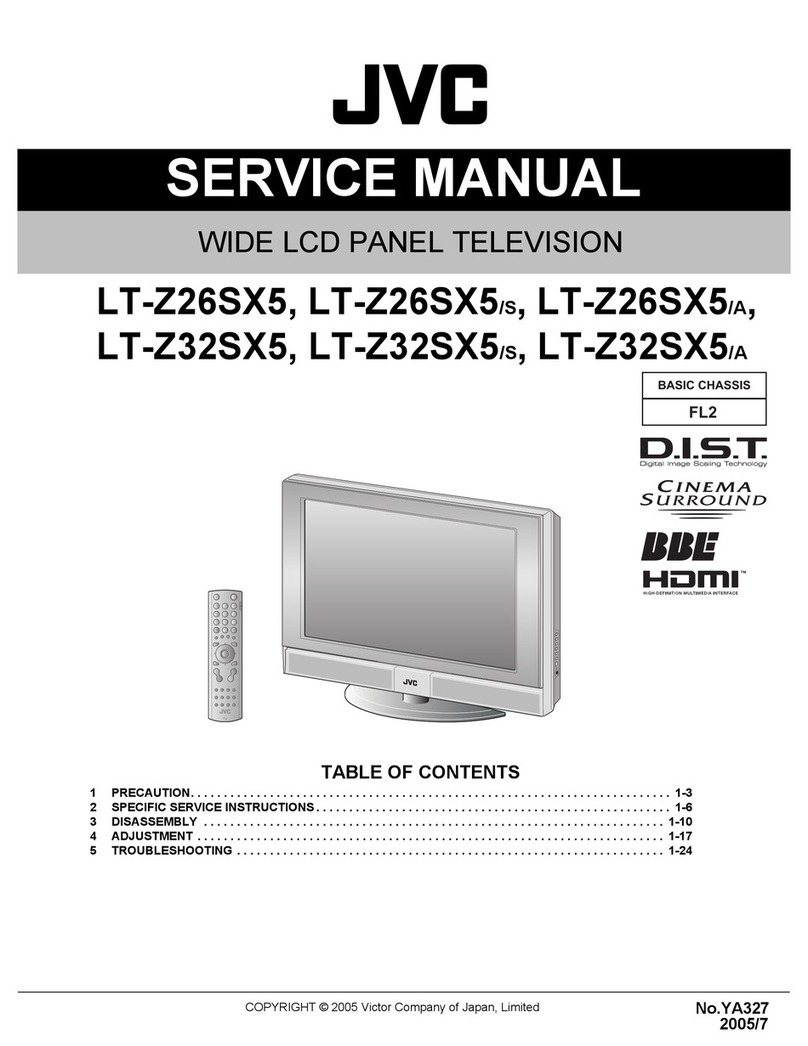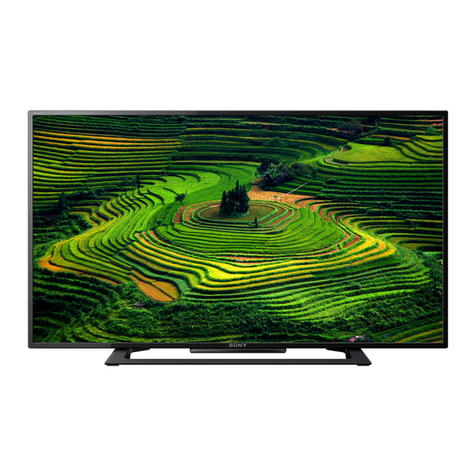VisionQuest LVQ-37HLR-FHD User manual

THIS PRODUCT HAS BEEN TESTED AND FOUND TO COMPLY WITH REGULATORY SAFETY
CYRTIFICATIONS.
This product is designed and manufactured to operate within defined design limits, and misuse may
result in electric shock or fire. To prevent the product from being damaged, the following rules should be
observed for the installation, use and maintenance of the product. Read the following safety instructions
before operating the display. Keep these instructions in a safe place for future reference.
• To avoid the risk of electric shock or component damage, switch off the power before connecting other components to
the LCD TV.
• Unplug the power cord before cleaning the LCD TV. A damp cloth is sufficient for cleaning the LCD TV. Do not use a
liquid or a spray cleaner for cleaning the product. Do not use abrasive cleaners.
• Always use the accessories recommended by VISIONQUEST to insure compatibility.
• When moving the LCD TV from an area of low temperature to an area of high temperature, condensation may form on
the housing. Do not turn on the LCD TV immediately after this to avoid causing fire, electric shock or component damage.
• Do not place the LCD TV on an unstable cart, stand, or table. If the LCD TV falls, it can injure a person and cause
serious damage to the appliance.
• A distance of at least 3 feet should be maintained between the LCD TV and any heat source, i.e. radiator, heater, oven,
amplifier etc. Do not install the product close to smoke. Operating the product close to smoke or moisture may cause fire
or electric shock.
• Slots and openings in the back and bottom of the cabinet are provided for ventilation. To ensure reliable operation of the
LCD TV and to protect it from overheating, be sure these openings are not blocked or covered. Do not place the LCD TV
in a bookcase or cabinet unless proper ventilation is provided.
• Never push any object into the slot on the LCD TV cabinet. Do not place any objects on the top of the product. It could
short circuit parts causing a fire or electric shock. Never spill liquids on the LCD TV.
• The LCD TV should be operated only from the type of power source indicated on the label. If you are not sure of the type
of power supplied to your home, consult your local power company.
• The power cable must be replaced when using different voltage from that specified in the User Manual. For more
information, contact VISIONQUEST.
• The LCD TV is equipped with a three-pronged grounded plug, a plug with a third (grounding) pin. This plug will fit only
into a grounded power outlet as a safety feature. If your outlet does not accommodate the three-wire plug, have an
electrician install the correct outlet, or use an adapter to ground the appliance safely. Do not defeat the safety purpose of
the grounded plug.
• Do not overload power strips and extension cords. Overloading can result in fire or electric shock.
• The wall socket should be installed near the equipment and should be easily accessible.
• Do not touch the power cord during lightning. To avoid electric shock, avoid handling the power cord during electrical
storms.
• Unplug the unit during a lightening storm or when it will not be used for long period of time. This will protect the LCD TV
from damage due to power surges.
• Do not attempt to repair or service the product yourself. Opening or removing the back cover may expose you to high
voltages, the risk of electric shock, and other hazards. If repair is required, please contact VISIONQUEST and refer all
servicing to qualified service personnel.
• Keep the product away from moisture. Do not expose this appliance to rain or moisture. If water penetrates into the
product, unplug the power cord and contact VISIONQUEST. Continuous use in this case may result in fire or electric shock.
• Do not use the product if any abnormality occurs. If any smoke or odor becomes apparent, unplug the power cord and
contact VISIONQUEST immediately. Do not try to repair the product yourself.
• Avoid using dropped or damaged appliances. If the product is dropped and the housing is damaged, the internal
components may function abnormally. Unplug the power cord immediately and contact VISIONQUEST for repair.
Continued use of the product may cause fire or electric shock.
• Do not install the product in an area with heavy dust or high humidity. Operating the product in environments with heavy
dust or high humidity may cause fire or electric shock.
• Hold the power connector when removing the power cable. Pulling the power cable itself may damage the wires inside
the cable and cause fire or electric shock. When the product will not be used for an extended period of time, unplug the
power connector.
• To avoid risk of electric shock, do not touch the connector with wet hands.
• Insert batteries in accordance with instructions while using the remote control. Incorrect polarities may cause damage
and leakage of the batteries, operator injury and contamination of the remote control.
• If any of the following occurs, please contact VISIONQUEST:
zThe power connector fails or frays.
zLiquid sprays or any object drops into the LCD TV.
zThe Display is exposed to rain or other moisture.
zThe Display is dropped or damaged in any way.
zThe performance of the Display changes substantially.
• Operating environment: Temperature: 40°F ~ 95°F, Humidity: 10% to 90% non-condensing, Altitude: 0~10,000 ft.
1

Note: In some countries or regions, the shape of the power plug and power outlet may sometimes
differ from that shown in the explanatory drawings. However, the method of connecting and
operating the unit is the same.
Television Antenna Connection Protection
External Television Antenna Grounding
If an outside antenna/satellite or cable system is to be connected to the LCD TV, make sure that
theantenna/satellite or cable system is electrically grounded to provide some protection against voltage
surges and static charges.
Article 810 of the National electrical Code, ANSI/NFPSA 70, provides information with regard to proper
grounding of the mast and supporting structure, grounding of the lead-in wire to an antenna discharge
unit, size of the grounding conductors, location of antenna discharge unit, connection to grounding
electrodes, and requirements of the grounding electrode.
GROUND CLAMP
ANTENNA LEAD-IN WIRE
A
(NeC SeCTION 810-20)
NTENNA DISCHARGE UNIT
GROUNDING CONDUCTORS
(NeC SeCTION 810-21)
GROUND CLAMPS
POWER SERVICE GROUNDINE ELECTRODE SYSTEM
(NeC ART 250, PART H)
ELECTRIC SERVICE EQUIPMENT
Lightning Protection
For added protection of your LCD TV during a lightning storm or when it is left unattended
or unused for long periods of time, unplug the LCD TV from the wall outlet and disconnect
the antenna/satellite or cable system.
Power Lines
Do not locate the antenna near overhead light or power circuits, or where it could fall into
such power lines or circuits.
2

Opening the Package
your VISIONQUEST HDTV is packaged in a carton together with other standard
accessories. Any optionalaccessories would be packed separately in another
carton.Due to the size and weight of the product, it issuggested
that it be handled by a minimum of 2 persons.
Since the glass can be easily scratched or broken, please handle the product gently.
Never place the unit on a surface with the glass facing downwards unless it is on
protective padding.When opening the carton, check that the product is in good
condition and that all standard accessories and items are included.
IMPORTANT: Save the original box and all the packing material for future shipping needs.
Package Contents
VISIONQUEST HDTV
Remote Control by Universal electronics
Audio Video Cable (yellow, red and white connectors)
Power Cord
This User guide
Quick Setup guide
Registration Card
3

Additional VISIONQUEST Certified Accessories for the
VISIONQUESTHDTV are sold separately:
Wall Mounts
High Definition Cables
extra or replacement Remote
Installation Preparation
Please read the user manual carefully before performing the installation.
The power consumption of the display is approximately 250watts, please use the power
cord designated for the product. When an extension cord is required, use one with the
correct power rating. The cord must be grounded and the grounding feature must not be
defeated.
The product should be installed on a flat surface to avoid tipping. Space should be
maintained between the back of the product and the wall for proper ventilation. If you
would like to mount the TV to the wall, please see “Preparing the LCD for Wall Mounting”
below for additional information. Avoid installing the product in the kitchen, bathroom or
other places with high humidity, dust or smoke, so as not to shorten the service life of the
electronic components.
Please ensure the product is installed with the screen in landscape orientation. Any 90°
clockwise orcounterclockwise installation may induce poor ventilation and excessive
component damage.
Preparing Your LCD TV for Wall Mounting
The VISIONQUEST can either be kept on the stand base or mounted to the wall for viewing.
If you choose to mount the HDTV to the wall, please follow the instructions below for
removing the base stand.
To remove the stand base:
1. Unplug all the cables and cords from your LCD TV.
2. Place the LCD TV face down on a soft and
flat surface (blanket, foam, cloth, etc) to
prevent any damage to the display.
3. Remove the 6 screws on the back panel of
the TV located near the bottom so that the
base stand can be removed. (see Figure 3.3a)
4. gently pull the stand away from the di
splay by grasping firmly to the base.
5. Now the display can fit securely to a mount (sold separately) by utilizing the mounting
holes in the center of the back panel of the display (see Figure 3.3b). Please make sure to
read the directions of your specific wall mount to properly hang the HDTV. Make sure the
wall mount is rated to support at least 65 lbs.
4
see Figure 3.3a
see Figure 3.3b

CONTENTS
1. Descriptions of Main Unit and Remote-Control Unit..................................................6
1.1 Front Panel Control ..................................................................................................6
1.2 Remote-Control Unit.................................................................................................7
1.3 Illustration of the Interface Panel................... ...........................................................9
4. Specifications...............................................................................................................19
2. Connection and Preparation........................................................................................10
2.1 Connect Antenna or Video Facility..........................................................................10
2.2 Battery Installation of Remote-Control Unit.............................................................10
2.3 Auto Search the Channels.........................................…..........................................10
5. The OSD Menus.............................................................................................................20
6. PC display mode............................................................................................................30
7. Trouble Shooting.....................………………...............................................................31
5
3. Connecting Equipment
.......................................................................................................11

1. Descriptions of Main Unit and Remote-Control Unit.1
1.1 Front Panel Control
1.1.1. POWER: Press to turn on and off the TV.
1.1.2. INPUT: Press to show the input source mode.
1.1.3. Menu :Menu display.
1.1.4. CH+/-: Press to scan thought channels.
1.1.5. VOL +/-: Press to turn up/down the volume
14
6

1.2 Remote-Control Unit
7

POWER Press this button to switch on the TV when at standby mode or enter
standby mode.
MUTE Press this button to mute or restore sound.
0~9 Press the number buttons to select a channel.
DISPLAY
Switch between the current TV channel and the last.
VOL+/VOL- Volume decrease or increase choice.
ZOOM
MENU
Show that the current mode of information.
CH+/CH-
Press these buttons to select ch annels in descending or ascending
order.
▲
Menu up
▼
Menu down.
◄
Menu right
►
Menu left
Enter
Press this key enters chose item.
EXIT
Press this button to exit from the current menu.
Press this button to enter the menu screens for various optional
adjust able settings.
INPUT
Press this button to switch among TV broadcast, AV input program
and other source.
PMODE Press this button to select the desired picture mode.
SMODE Press this button to select the desired sound mode.
SLEEP Press this button to set the sleep timer. When the preset length of time
has passed, the TV set enters standby mode.
8
RETURN
MTS
Press this button to select the desired display mode.
CC
EPG Electronic program guide.
FAV Favorite television programs
FAV+ Favorite television programs up.
FAV- Favorite television programs down.
Mono,Stereo and Sap.
Press this button to select the channel-children.(for example:10-1)
Press this button to open or close caption.

1.3
Illustration
of
the
Interface
Panel
Back panel control
1
YPBPR1-Right Audio in
11
2
YPBPR1-LEFT Audio In
12
3
YPBPR2-Right Audio in
13
4
YPBPR2-LEFT Audio In
14
5
CVBS&S-VIDEO Right Audio In
15
6
CVBS&S-VIDEO Left Audio In
16
7
YPBPR2-Y
17
8 18
9 19
10 20
9
YPBPR1-Y
YPBPR2-PB
YPBPR1-PB
YPBPR2-PR
YPBPR1-PR
PC-Audio In
PC-RGB In
HDMI1
HDMI2
S-video In
CVBS In
Coaxial Output Terminal
TV Signal In

2. Connections and Preparation
2.1 Connect Antenna or Video Facility
1. Use 75Ωcoaxial cable plug or 300-75Ωimpedance converter to plug in antenna
input terminal on the rear of the cabinet.
2. Connect the video facility to the audio, video in jack on the rear of the cabinet.
2.2 Battery Installation of Remote-Control Unit
1. Turn the remote-control unit upside down. Scratch the grip of the battery
compartment
2. Install two new 1.5V AAA batteries, make sure the anode and cathode of the
batteries matches the “+”, “–” marks inside the battery compartment. Or not it would
damage the unit.
3. Close the battery compartment cover.
2.3 Auto Search the Channels
1. Press the Power On/Off button on the local machine or Remote-Control Unit.
2. Press the MENU button on the remote-control unit, then the screen displays the OSD
menu. Select your native language in Menu Language which is in the Setup directory
3. Start Auto Ch Search
10

3. Connecting Equipment
3.1 - Which Video Connection Should I Use?
This HDTV has six different ways to connect your video equipment from a basic
connection to the most advanced for digital displays.
ConnectionQuality(type) Connector Description
best(digital)
Digital HD (HDMI - High-Definition
Multime-dia Interface) - It is the first and
only industry-supported, uncompressed,
all-digital audio/video interface. HDMI
provides an interface between any
audio/video source, such as a set-top box,
DVD player, or A/V receiver and an audio
and/or video monitor, such as a digital
television (DTV), over a single cable.
best(digital)Left
DTV Coaxial RF. When used for MPeg2
encoded bit streams from ATSC broadcast
programming, this input takes advantage
of the High Definition content.
best(analog)
Analog Rgb (VgA) - This video input has
seperate red, green and blue color
components. The signal carries
horizontal and vertical sync information on
the green signal. This is most commonly
used for PC input
better(analog)
Analog HD1/HD2 (Component) - The video
signal is separated into three signals, one
containing the black-and-white information
and the other two containing the color
information. This enhancement over
S-Video takes advantage of the superior
picture provided by progressive scan DVD
players and HDTV formats.
good(analog)
S-
Video (AV ) - The video signal is
separated into two signals, one containing
the black-and-white information and the
other containing the color information.
Separating the color in this way avoids
‘cross color’ effects where closely spaced
black and white lines are erroneously
displayed in color. It also enables text to
be displayed more sharply.
good(analog)
AV1/AV2/AV (Composite) - The complete
video signal is carried through this single
pin connector. This is the most commonly
used video connection.
good(analog)Right
TV Coaxial RF. This is the connection for
standard NTSC TV using antenna or cable.
If you have a VCR, you can connect your
antenna/cable to the VCR RF Input and
connect the VCR RF Output to this
connector.
11

3.2 - Connecting Your DVD Player
you have several options for connecting your DVD player to your new L 2 HDTV – HDMI
(Digital HD), Component (Analog HD), S-Video (AV), and Composite (AV) inputs. based
on your home theater configu-ration, you can decide which option is the right one for you.
3.2.1 - Using HDMI (Digital HD)
DVD players that have a digital interface such as HDMI (High-Definition Multimedia
Interface) should be connected to the HDMI input of the HDTV for optimal results.
Connecting DVD Player (Best):
1. Turn off the power to the LCD TV and DVD player.
2. Connect a HDMI cable to the HDMI output of your DVD player and the other end to the
HDMI input (white color area) in the rear of your LCD TV.
3. Turn on the power to the LCD TV and your DVD player.
4. Select Digital HD using the INPUT button on the front of the LCD TV or directly by
pressing the INPUT button on the Remote Control.
Note: Refer to your DVD player user manual for more information about the video
output requirements of the product.
12

For DVD Players with DVI:
1. Turn off the power to the LCD TV and DVD player.
2. Using a HDMI-DVI cable, connect the DVI end to your DVD Player and the HDMI end to
the HDMI input (located in the white area) in the rear of your LCD TV.
3. Using an audio cable (white and red connectors), connect cable to the audio output
connecters associated with the DVI out put on the rear of your DVD Player, and
connect the other end to the audio connectors (white area) associated with the
HDMI input in the rear of your LCD TV.
4. Turn on the power to the LCD TV and your DVD Player.
5. Select digital HD using the input button on the front of the LCD TV or directly by
pressing the INTPUT button on the remote control.
13

3.2.2 - Using Component (Analog HD1) Video
Connecting DVD Player (Better):
1. Turn off the power to the LCD TV and DVD player.
2. Using the connectors in the green color area, connect the y (green color) connector on
the rear of your DVD player to the corresponding y (green color) connector in the
Component Analog HD1 group (green color band) in the rear of your LCD TV.
3. Connect the Pb (blue color) connector on the rear of your DVD player to the
corresponding Pb (blue
color) connector in Component Analog HD1 group
(green color band) in the rear of your LCD TV.
4. Connect the Pr (red color) connector on the rear of your DVD player to the
corresponding Pr (red color) connector in the Component Analog HD1 group (green color
band) in the rear of your LCD TV.
5. Connect the R (red color) and L (white color) audio connectors on the rear of your DVD
player to the R (red color) and L (white color) audio input connectors in the Component
Analog HD1 group (green color band) in the rear of your LCD TV.
6. Turn on the power to the LCD TV and DVD player.
7. Select Component Analog HD1 using the INPUT button on the remote or front of the
LCD TV or directly by pressing the INPUT button on the Remote Control.
Note:
a) If you are already using the Component Analog HD1 input for another component, or
you do not want to use the Component Analog HD1 input for the DVD
player, you
can connect the DVD player to the Component Analog HD 2
connections coded by
b) Refer to your DVD player user manual for more information about the video output
requirements of the product.
the blue color area.
14

3.2.3 - Using Composite (AV) Video
Connecting DVD Player (Good):
1. Turn off the power to the LCD TV and DVD player.
2. Connect the S-Video jack on the rear of your DVD player to the S-Video jack in the AV
In group on the side of your LCD TV.
3. Connect the R (red color) and L (white color) audio connectors on the rear of your DVD
player to the R (red color) and L (white color) audio input connectors in the side of your
LCD TV.
4. Turn on the power to the LCD TV and DVD player.
5. Select AV using the INPUT button on the remote or front of the LCD TV or directly by
pressing the AV button on the Remote Control three times.
Note: Refer to your DVD player user manual for more information about the video output
requirements of the product.
15

3.3 Connecting Coaxial (RF)
There are several options for connecting your antenna (or cable for TV) to your new HDTV
- directly to the DTV, NTSC TV or through your VCR. based on your home the ater
configuration, you can decide which option is the right one for you.
3.4.1 - Using Your Antenna or Digital cable for DTV
1. Turn off the power to your LCD TV.
2. Connect the coaxial (RF) connector from your Antenna or Digital Cable to the DTV
connector on the rear of your LCD TV.
3. Turn on the power to your LCD TV.
4. Select DTV using the INPUT button on the front of your LCD TV or directly by pressing
the Digital HD button on the Remote Control twice.
Note:
a) Digital broadcasts are not available in all areas.
b) Make sure the antenna is correctly grounded.
16

3.4.2 - Using Your Antenna or Cable TV
1. Turn off the power to your LCD TV.
2. Connect the coaxial (RF) connector from your antenna, cable or cable box to the TV
connector on the rear of your LCD TV.
3. Turn on the power to your LCD TV.
4. Select TV using the INPUT button on the front of your LCD TV or directly by pressing
the NTSC TV button on the Remote Control.
3.4.3 - Using the Antennaor Cable through Your VCR
Note: If you have an off-air antenna or cable TV, connect the off-air antenna or TV cable
to the RF connec tor on the rear of your VCR.
17

1. Turn off the power to your LCD TV and Computer.
2. Connect a 15-pin D-sub Rgb (VGA) cable to the Rgb output of your computer and the
other end to the RGB input (purple area) in the rear of your LCD TV.
3. Connect the Audio Out on your computer to the Rgb Audio (purple band) at the rear of
your LCD TV.
4. Turn on the power to your LCD TV and computer.
5. Select RGB using the INPUT button on the front of your LCD TV or directly by pressing
the RGB button on the Remote Control.
Note:
a) For the best picture quality when connecting a computer through Rgb, set your
computer timing mode to VESA 1360 x 768 at 60 Hz or 1024 x 768 at 60 Hz.
Please refer to the graphic Card’s user guide for additional
information on how to set the timing mode.
b) Refer to your computer user manual for more information about the video output
requirements of the product.
c) Stereo mini jack cable is not included and can be purchased at an electronic store.
3.5 - Connecting a Computer
18

4. Specifications
Items Relevant illustrations
Screen size,
visible 37 LCD TV
Screen format 16:9
Resolution 1920X1080
Maximum
contrast ratio 850:1
Active Display
Area 819.36H)X460.89(V)
Maximum
brightness 500 cd/m²
Response time 5ms
Display colors 16.7M
Maximum
viewingangle 178° (Horizontal) / 178° (Vertical)
Maximum
lifetime of 50,000 hours
Dimension
(packed) 1025x370x780mm
Accessories Remote-Control, Power cord, Attention cord,Registration card, User Guide,
Power
requirement AC 100~240V, 50/60Hz
Normal Power
Dissipation ≤250W
The whole machine
parameters
Standby Power
Dissipation <5W
TV system NTSC+ATSC
Audio Output 2×10W
OSD language
Local control
ke
y
s INPUT,MENU , CH-, CH +,VOL-, VOL+ ,POWER
TV
AV
TWO-ROAD YPBPR;HDMI;AV IN;ONE-ROAD S-VIDEO;
PC-Audio IN;PC-VGA IN three-road L/R audio
Note:
All specifications are subject to change without notice.
19
quick Set up Guide,batteries
English/French/Spanish

Basic operation
Intitial Setup Menu
NOTE: If this is the first time you run the LCD TV, the Initial Setup Menu will appear in the picture, and
the items of this menu also exist in other menus, so you are able to change the values after you
set them up.
Tuning Band
Initial Setup Menu
Menu Language
Auto Ch Search
English
Air
To Move To Select To Exit
Enter Menu
Menu Language
Press ▼ / ▲ button to select this item, then press ENTER/► button to select the OSD language.
Auto Ch Search
Press ▼ / ▲ button to select this item, then press ENTER/► button to enter the Auto Channel Search Program.
Tuning Band
Select Tuning Band mode. (Available tuning band mode: Air, Cable STD, Cable HRC, Cable IRC, Cable Auto.)
If sets Air, the range of channel is 2-69, and if sets Cable,the range of channel is 1-135.
The OSD (On Screen Display) function enables you to adjust the screen status conveniently since it provides
graphical presentation.
Choosing a TV channel
1. Press CH+/CH- button on the front panel or on the remote control.
Press CH+ button for the next channel
Press CH - button for the previous channel.
2. Press 0-9 buttons and -/-- button.
You can select the channel by pressing 0 to 9 buttons directly for the channel you want.
3. Example:
To select 1-digit channel (e.g. Channel 5): Press the 5 and ENTER button.
To select 2-digit channel (e.g. Channel 20): Press the 2 and 0 buttonts,then press ENTER button.
To select 3-digit channel (e.g. Channel 103): Press the 1 and 0 and 3 buttons,then press ENTER button.
Note: After select the digit button, the digit will be memorized.
Press the button to enter a program number for digital program channel.-/--
To select a program number for multiple program channel (e.g. Channel 2-1):Press the 2 button, then press -/-- and 1
button,then press ENTER button.
5.Menu Operation
20
Table of contents
Other VisionQuest LCD TV manuals





